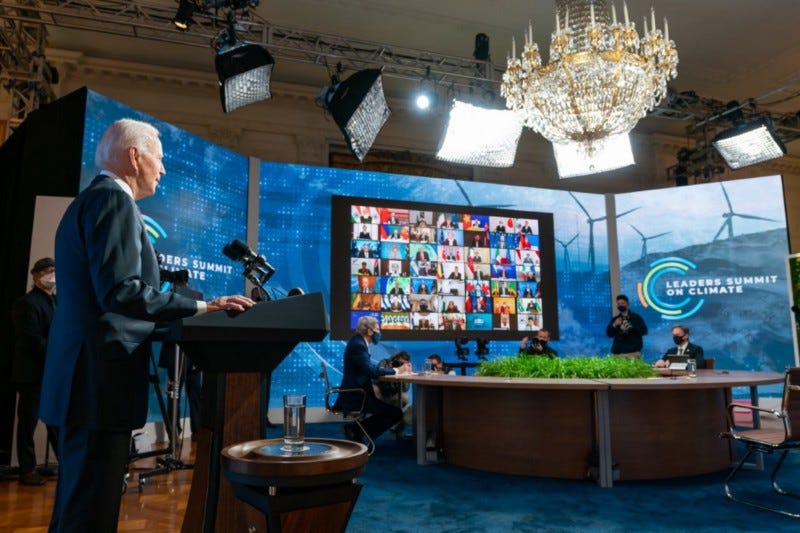Biden’s climate summit achieved its goals. Kind of.
We break down the top goals of Biden’s Earth Day summit, and how the U.S. did (and did not) achieve them.
Last week, the United States hosted the Leaders Climate Summit, a two-day virtual forum to promote international coordination on climate action. Attended by 40 world leaders, the summit intended to present the U.S. as a leader on global climate efforts, while pressuring other countries to make more ambitious commitments.
“We’re here at this summit to discuss how each of us, each country, can set higher climate ambitions that will in turn create good-paying jobs, advance innovative technologies, and help vulnerable countries adapt to climate impacts,” said President Joe Biden at the summit.
So, just how well did the White House achieve its intentions? In this post, we break down the top goals of the summit, and how the U.S. did (and did not) achieve them.

Positioning the U.S. as a leader in global climate efforts
After four years of Trump, simply getting back in the climate group chat is a necessary first step. Biden shouldn’t be congratulated for simply hosting a summit, but in a way, it’s a win that 40 world leaders attended, including China and Russia, which put aside very public riffs with the U.S. to commit to reducing emissions.
To further position itself as a leader in global climate efforts, the U.S. unveiled its much-anticipated emissions target at the summit, pledging to cut 50–52% of the nation’s greenhouse gas emissions by 2030 — roughly double the target set by the Obama administration in 2015. As The New York Times explains, that’s one of the more aggressive near-term climate targets for wealthy, industrialized nations.
And to own up to its role as one of the largest economies, the U.S. also announced its first-ever international climate finance plan, pledging to double funding to developing countries to address climate change and triple funding for adaptation by 2024.
Pressuring countries to slash emissions
As France President Emmanuel Macron put it at the summit, “2030 is the new 2050.” That’s why much of the meeting focused on generating renewed commitments to halve emissions by 2030. Reaching this near-term target would allow countries to realistically hit net-zero emissions by 2050 — the target set by the Paris Agreement to limit global temperature rise to 1.5 degrees Celsius.
Through that lens, the summit did make some ground. In the leadup to the event, the European Union committed to cut emissions 55% by 2030, and the United Kingdom pledged to cut emissions 78% by 2035. And at the summit, Japan pledged to cut emissions 46% by 2030, and Canada pledged to cut emissions 40–45% by 2030.
South Korea, which intends to announce a more ambitious climate target later this year, announced it would stop financing coal-fired power plants overseas. And Brazil unveiled its goal to reach net-zero emissions by 2050, 10 years sooner than its previous commitment.
But they weren’t all Ws. Though China promised to limit, then phase out coal consumption by 2030, it did not update its previous pledge to hit net zero emissions by 2060. Nor did it offer an updated near-term plan, like other countries.
India, Russia, and Australia also refused to budge on their near-term climate targets. Taken together, these misses call into question the success of the summit.
Limiting global warming
The overarching goal of the summit, however, wasn’t mere politics or goal-setting — it was limiting global warming to 2 degrees, or preferably 1.5 degrees, Celsius above pre-industrial levels. And to do that, we need action.
“The commitments we’ve made must become real,” Biden said at the close of the summit. “Commitment without doing anything is a lot of hot air, no pun intended.”
For his part, Biden is currently seeking $2.3 trillion from Congress for a sweeping infrastructure plan that would expand electric vehicle charging stations and create a new, greener electric grid. To win over skeptics, Biden has repeatedly presented climate action as an economic winner, framing much of his climate action through job creation.
Limiting temperature rise will be a monumental task, requiring unprecedented international cooperation and scale. At the very least, the Leaders Climate Summit showed that the U.S. intends to be part of that effort. Whether they’ll lead it, though, is still unclear.



